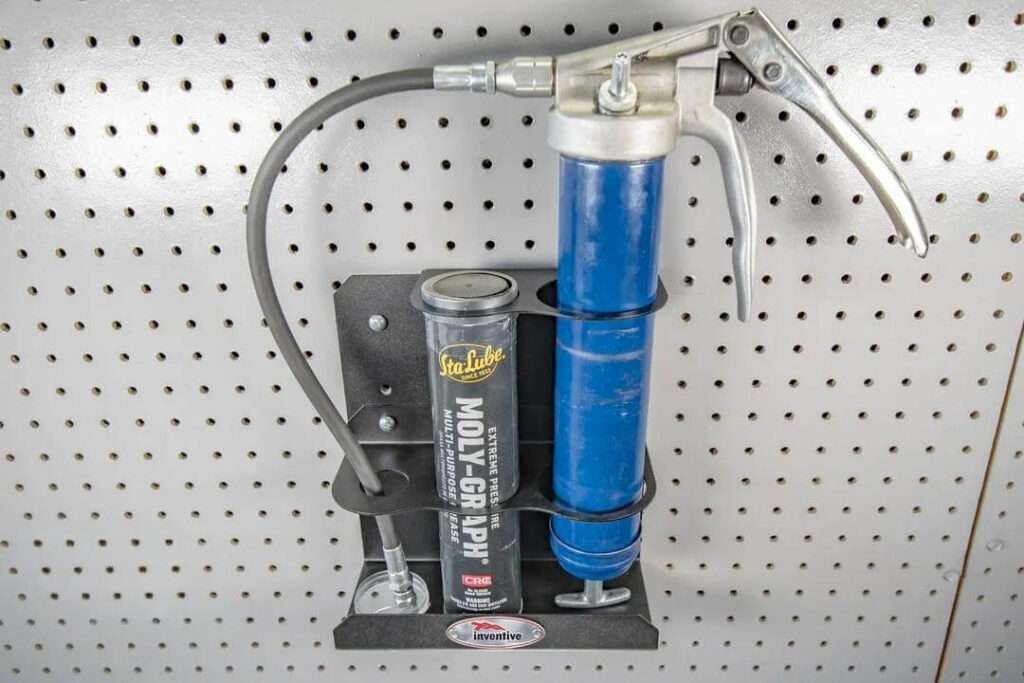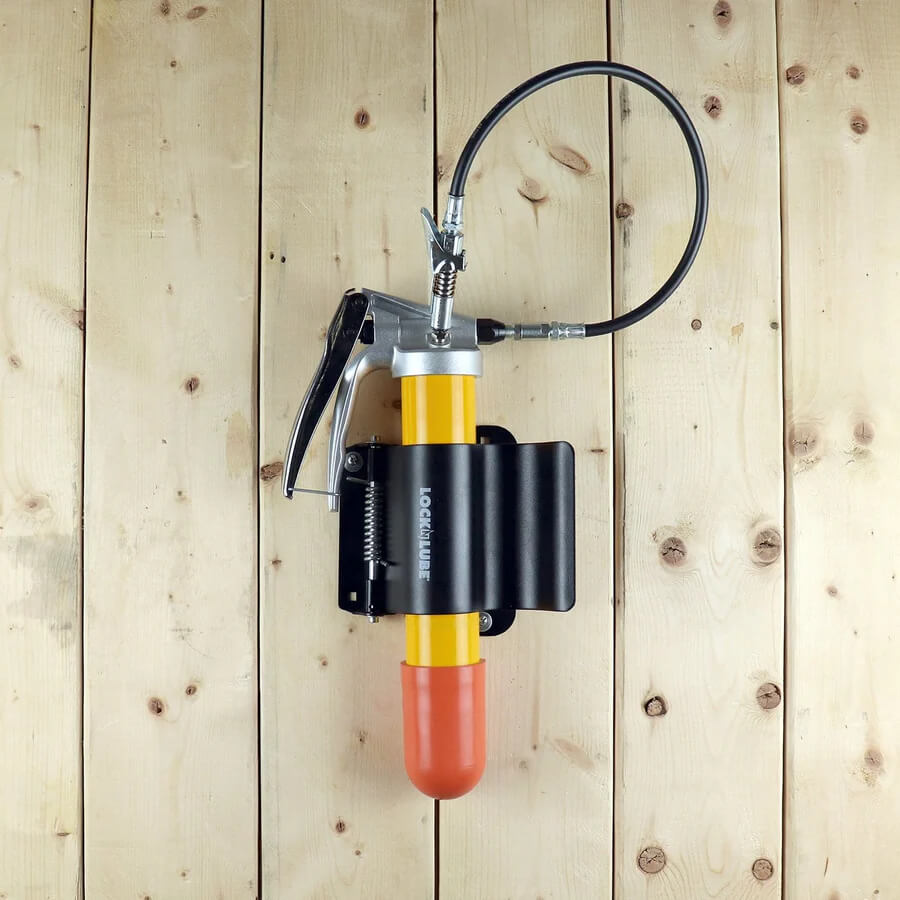A grease gun is a common tool used to apply lubricant or grease to mechanical equipment and machinery. Grease guns allow you to pump grease into bearings, universal joints, and other parts that need lubrication. They provide a controlled way to apply the exact amount of grease required.
Grease guns are a staple tool for automotive mechanics, factory workers, farmers, and anyone maintaining equipment. They come in manual, pneumatic, and battery-powered models. The most common style is a hand-powered lever model that you pump to build pressure.
Grease guns make lubrication jobs much cleaner and easier compared to using your hands. They can pump through a nozzle into tight spaces. Grease guns allow you to lubricate equipment while it’s still assembled and in use. Proper lubrication is essential for reducing wear and tear, preventing overheating, and extending the service life of mechanical equipment.
Some Good Ways to Store a Grease Gun
Storing in a Tool Box
Storing a grease gun in a toolbox offers a convenient and organized way to keep the tool accessible while also protecting it. Here are some key benefits and tips for storing a grease gun in a toolbox:
- Keeps the grease gun and grease cartridges in one place so they are easy to find when needed. No more hunting around the garage for them.
- Protects the grease gun from getting knocked around or damaged. The toolbox keeps it safely contained.
- Allows you to neatly organize the grease gun with other tools and supplies. A toolbox with dividers or slots helps keep everything in its place.
- Portable for taking the grease gun to job sites or where greasing needs to be done outside of the workshop. The toolbox keeps everything together.
Hanging Storage

Hanging storage is an excellent solution for keeping grease guns organized and readily available. It is crucial to select a durable wall mount or hook made of sturdy metal that can support the tool’s weight. The ideal hanging height is around 4-5 feet, enabling easy retrieval and placement of the grease gun. It’s best to hang it near where it will be frequently used, such as in a workshop or garage, to save time and effort.
To prevent damage, the grease gun should be hung by its handle or frame, not by the hose. You may choose to hang it nozzle-down to prevent grease leakage, but hanging it nozzle-up is also acceptable if wiped clean after each use. For added protection, hanging the grease gun inside a plastic holster or sleeve is recommended to keep dust and debris away.

When hanging multiple grease guns, ensure they are spaced apart to avoid collision. Screw-in hooks or wall mounts are recommended to prevent loosening over time. Consider also hanging a small rag or paper towel nearby to conveniently wipe down the grease gun after usage.
Hanging storage keeps tha grease gun off the floor, saves space, and ensures efficient and organized tool management.
Make Sure to Clean Your Gun Before Storing
Properly cleaning your grease gun before storing it is one of the most important steps you can take to maintain its performance and extend its lifespan. Allowing used grease or contaminants to sit inside the gun’s barrel or hose can lead to clogs and jams the next time you go to use it. It can also cause internal corrosion over time.
Make sure to fully purge any remaining grease from the barrel. The best way is to attach the grease coupler and pump the handle until no more grease comes out. You may need to use a rod or pipe cleaner to fully clear out any stubborn grease deposits inside the barrel.
Also, take the time to wipe down the exterior surfaces with a clean rag. Remove any dirt, grease smears, or other debris. This prevents abrasive particles from causing wear and prevents grease from getting on your hands or clothes when you retrieve the stored grease gun.
Proper cleaning takes just a few extra minutes but goes a long way in maintaining your grease gun’s performance. Storing a dirty grease gun can lead to frustrating malfunctions and possibly shorten its usable lifespan over time. So be sure to clean it thoroughly before putting it into storage.
How to Store Grease Cartridges?
When storing grease cartridges, it’s important to follow best practices to prevent leakage, contamination, and damage. Here are some tips:
- Store cartridges upright and securely: Laying cartridges on their side risks grease leaking out of the tip. Store cartridges in a way that prevents them from falling over or rolling around. Use storage racks, bins, or cases that hold cartridges upright.
- Keep caps and tips protected: Replace the cap tightly after use to seal in the grease. Store-capped cartridges point down so grease doesn’t leak out. You can also cover the tips with plastic wraps or bags as an extra barrier.
- Prevent crushing damage: Don’t place heavy objects on top of cartridges that could bend or crush them. Use storage methods that separate and cushion cartridges.
- Avoid temperature extremes: Don’t store cartridges in areas that get very hot or cold, which could negatively affect the grease properties. Maintain storage temps between 40-100°F.
- Separate from solvents: Don’t store cartridges near brake cleaners, gasoline, or other chemicals that could degrade the grease seals and contaminate the grease.
- Use the oldest first: When using multiple cartridges, take the older ones out of storage first to prevent the grease from oxidizing and thickening over time. Rotate your stock.
- Check for leaks before use: Inspect cartridges before installing to ensure the seals are intact and no grease has leaked out from long storage. Leaky cartridges should be discarded.
Prevent Rust For Longterm Use of Grease Gun
Rust can cause significant damage to a grease gun over time if it is not stored properly. Here are some practical tips to prevent rust and ensure the longevity of your grease gun:
After each use, meticulously wipe down the grease gun. Remove any excess grease, dirt, and debris with a lint-free cloth dampened with a suitable solvent like kerosene. This simple step helps eliminate potential contaminants that could lead to rust formation.
Apply a thin layer of oil to the metal parts of the grease gun. Rub a light oil such as WD-40 over the metal surfaces to create a protective barrier against moisture and prevent direct contact with bare metal. Regularly reapplying oil, ideally every few months, helps maintain this protective coating.
Incorporate a moisture-absorbing desiccant into your storage routine. Place desiccant packs in close proximity to the grease gun within the storage container. These packs effectively absorb ambient moisture, creating a dry environment that reduces the risk of rust. Be sure to replace the desiccant packs as per the package instructions to maintain their effectiveness.
Store greased cartridges separately from the grease gun. To prevent grease from contacting the gun, it’s recommended to store full grease cartridges individually wrapped or in a separate box. This measure minimizes the risk of grease leakage, which can lead to the formation of rust.
Summary
Proper storage of your grease gun is important to keep it functioning properly and avoid any safety issues. Here’s a quick recap of the best practices:
- Store the grease gun upright to prevent leakage
- Keep grease cartridges sealed and store them upright to avoid leakage.
- Clean surfaces before storage, especially if exposed to water. Store in a dry area
- Clean the grease gun before long-term storage to remove grease and debris.
- Choose a convenient and secure storage location for the grease gun.